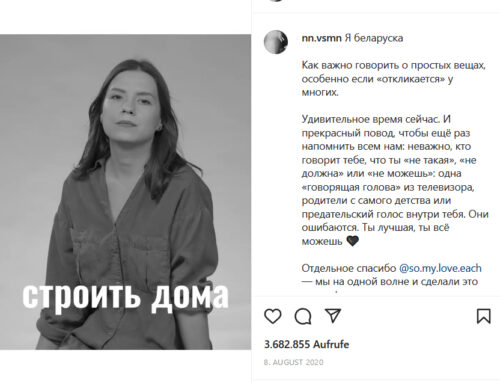With its video The DNA Journey, which has been viewed more than 17 million times, the flight comparison site Momondo landed a widely noticed and controversial viral hit in the summer of 2016.
Produced in cooperation with the family research platform AncestryDNA and published on various video portals as part of the ‘Let’s Open Our World’ advertising campaign, the five-minute short film captures the reaction of several dozen test persons from various countries to whom the result of a hereditary DNA test is disclosed. While a large part of the online media viewed the video positively and praised it as an important contribution against nationalist and racist ideas, it also faced criticism of being merely a marketing stunt without any honest activist concern.
Framed by the question ‘Would you dare to question who you really are?’ The DNA Journey suddenly begins with recordings of apparently overwhelmed and crying test persons without providing any context. Before solving the riddle of what exactly provoked such emotional outbursts, the video continues with a series of short portraits: stereotypically dressed, picture-book representatives of various nationalities – including a cheerful Cuban with dreadlocks, a man from Bangladesh dressed in traditional religious robes, and a young French woman with bob hair – explain why they are proud of their patriotism, why their respective countries are the best. In response to specific questions from one of the two interviewers, the test persons finally reveal various prejudices against other ethnic groups. After they have given a sample to have their respective countries of origin analysed from their DNA, they all reaffirm that there can be no doubt about their nationality. However, because of the reactions that were already shown, it is clear that the opposite will be the case.
Unsurprisingly for the viewers, the results of the DNA tests two weeks later actually reveal something that the test persons cannot understand: their genetic code is actually composed of a number of ethnic groups, the video claims, often even of ethnic groups from those countries that they were particularly critical of before. The foundation of their national pride begins to waver, the participants are obviously disturbed – and the Frenchwoman finally puts on record: ‘There would be no extremism in the world if people knew their origins so well.’ Finally, by a twist of fate, even two distant cousins among the participants are brought together, tearfully falling into each other’s arms to loud applause. At this point at the latest, the authenticity of the event comes into doubt. Finally, air tickets to their respective countries of origin are distributed to all participants before the link to the Momondo campaign website is displayed.
Travelling with Momondo as a personal contribution to a better, fairer world without racism seems to be the rather confused message in the end. It is precisely this interweaving of humanistic activist rhetoric and commercial advertising that is the biggest problem of The DNA Journey, which also angered many viewers. For example, the campaign website is directly integrated into the Momondo portal: although superficially the ‘value of travel’ and the intrinsic connection of all people is emphasised, the option of booking a flight with hotel still stands out. On closer inspection, The DNA Journey – along with its problematic romanticization of genetic origin as a true structure of personal identity – turns out to be almost anti-activist. While the Most Boring Viral Video created by the Arrels Fundacio, for example, undermines commercial advertising algorithms for activist purposes, The DNA Journey turns this subversive dynamic into its opposite and instead makes use of activist strategies and rhetoric for commercial purposes.
This commercial intention did not go unnoticed for long. The plot development seems too perfectly choreographed, the coincidences too deliberate, the reactions too exuberant to create the impression of a real research experiment, let alone an honest activist stand against xenophobia. Not only are the two hosts, dressed in white lab coats, in reality just a spokesperson for AncestryDNA and a professional actress, online users were also able to identify at least two actors among the test subjects. In addition, the accuracy and usefulness of the Ancestry method for determining genetic composition has been questioned on several occasions. Human genetics expert Sascha Willuweit from the Charité Hospital in Berlin, for example, complained to Spiegel Online that the video deliberately manipulates human feelings and expectations. Although it is possible to localise DNA on a continental scale, it is not possible at the level of an individual country.[1] Scientific reliability is rejected here in favour of a ‘romanticism of origin’ and a ‘desire for adventure’. The video’s claim to authenticity – capturing genuine reactions of real people to scientifically verified facts – does not stand up to closer scrutiny.
The almost 6000 comments on YouTube were also predominantly critical, despite isolated expressions of deep emotion. According to the tenor, the video seems ‘fake’ and ‘scripted’, the reactions of the protagonists ‘weird’ and ‘cringe-inducing’. As only a handful of test persons were portrayed, many users also expressed the suspicion that Momondo only used the most convincing performances to maximise the advertising effect. Correspondingly, one disillusioned user summarised: “Hm, that moment you realise this is all just an ad for a travel company”.
Eva Winterberg
[1] Willuweit, Sascha (2016): Viraler Videohit ‘The DNA Journey’ –‘Manipulation der menschlichen Gefühle’. http://www.spiegel.de/video/virales-video-zu-dna-analyse-ist-manipulativ-video-1682492.html



